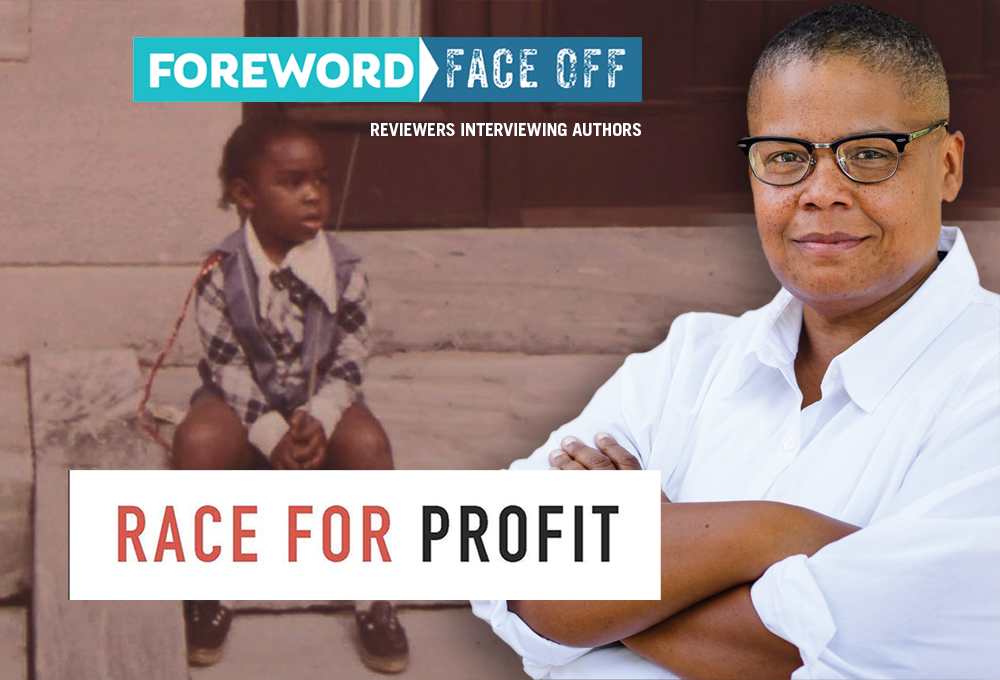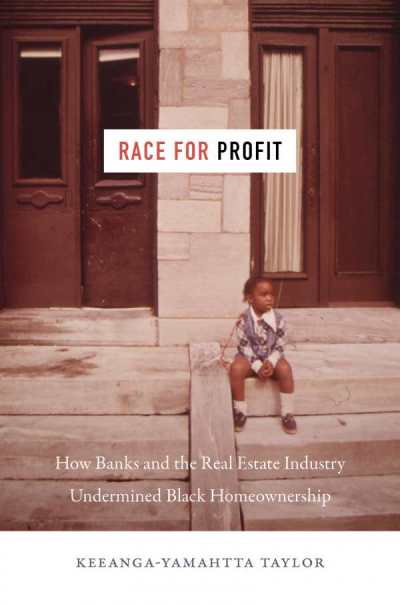Reviewer Jeff Fleischer Interviews Keeanga-Yamahtta Taylor, Author of Race for Profit

Reviewer Jeff Fleischer Interviews Keeanga-Yamahtta Taylor, Author of Race for Profit: How Banks and the Real Estate Industry Undermined Black Homeownership
You can count on it—every month or two, some headline-seeking pundit will slither on top of a soapbox to argue that, finally, we’ve achieved a post-racial society, that racism isn’t a problem in the United States anymore. And the rest of us go slack-jawed, appalled to the point of speechlessness. In fact, the evidence of racism is so widespread and systemic, the only way someone could come to the “post-racial” conclusion is if they lived as a recluse in a North Dakota bunker.

For another distressing example of racism’s pervasiveness, this week’s interview introduces Keeanga-Yamahtta Taylor, the author of Race for Profit: How Banks and the Real Estate Industry Undermined Black Homeownership. Among many eye-opening insights, in his research for the book Keeanga-Yamahtta discovered how The Housing and Urban Development Act of 1968 became the unwitting accomplice to helping private industry exploit the very people the Act was intended to benefit, including thousands of inner-city Black mothers—perhaps the most vulnerable of all citizens in this country.
In his review for the November/December issue of Foreword Reviews, Jeff Fleischer calls the book “an important addition to the literature on predatory lending and housing discrimination, as well as a valuable warning.”
And with that warning in mind, we reached out to the University of North Carolina Press for help in setting up this interview.
Jeff, take it from here.
How did you come to write Race for Profit? What was the genesis of the idea?
There are probably two origin stories for the book. In the early 2000s, I worked in Chicago as a “tenant advocate,” meaning that I worked with tenants, who faced eviction, to use Chicago’s Residential-Landlord Tenant Ordinance to discover if any of their rights had been violated. This was a key process in trying to keep tenants in their housing as landlords tried to evict them. I wanted to understand more about why the majority of the tenants who were drawn to my organization’s assistance were Black women, single mothers.
Our offices were located on the northwest side of Chicago, but most of the women I met with lived south. I knew that poverty played some role, but it was not the only role. Many of these women would come to our meetings plied with photos that documented the conditions of distress and dilapidation in their homes. They came with stories of children rendered sick by lack of heat, mold, or broken windows. Rarely were these women renting from families or a small landlord, but they were almost universally renting from management companies or landlords with multiple properties.
For me, this meant that the landlords kept these apartments in disrepair because it was beneficial to them. There was an expectation, as they almost always argued, that the women and their children were to blame for the condition of the apartment. I never heard a landlord take responsibility for the distressed condition of a property they were renting to a Black family on the south or west side of the city. I wanted to understand these dynamics. I wanted to understand the experiences of African American families in the private market. So much had already been written about African Americans in public housing, but the vast majority of Black families lived in private housing. I wanted to understand their world.
The second origin is that I was interested in how African Americans were navigating the private market. So much of what is written about black housing has been overly focused on the history and fate of public housing. Of course, public housing is incredibly important and getting that history correct is important, but most African Americans satisfy their housing needs in the private market. Given that, there is almost nothing written about the historical experiences of Black homeowners, so this was a story I was very interested in understanding.
Race for Profit demonstrates how both the public and private sectors created a market for substandard housing for African Americans. Do you see this as inevitable from the way the incentives were created, or how did it go so wrong?
I think these low-income homeownership programs created by HUD show that, at least in housing, there are conflicts of interest that are so deep that they cannot be overcome. Real estate and mortgage lending in the United States has been so complicit in the production of racial stereotype and in suturing race to risk, the notion that these institutions could then play a positive role in ending the housing crisis endured by African Americans for as long as they have been an urban population is not just naïve, it is dangerous.
Moreover, it is difficult to get beyond the reality that public policy is intended to protect the public’s welfare while private enterprise is intended to generate profit. These two conceptual opposites have never been rationalized in actual policy—from education, to healthcare, to the distribution of water and electricity, business models eventually distort these programs and result in their maldistribution. The market is predicated on winners and losers. This is a terrible framework for the distribution of goods and services that are necessary for the reproduction, health, and safety of the species.
You introduce the idea of “predatory inclusion” as a new and insidious form of discrimination. Can you talk a bit about how that concept became so dominant?
“Predatory inclusion” is intended to draw our attention to the fraught, contingent, and tiered access to institutions and markets from which African Americans were previously excluded. A central premise of postwar liberalism was that “equal opportunity,” access or inclusion into the institutions that shaped the experiences of middle-class white people could do the same for African Americans. This formulation accepted the assumption that these institutions were democratic, just, and colorblind; we were not compelled to question the institutions and the system they represented.
The experiences of Black people show that access alone was not the primary, or even an important issue. The experience of African Americans compels us to interrogate the institutions themselves, including the supposedly colorblind housing market and the multiple industries connected to it. What we find is that the housing industry is completely warped by theories of race and ingrained practices that sought to marginalize African Americans, promoted residential segregation, and monetized the harsh conditions of substandard housing in Black enclaves. Because the institutions themselves were deeply implicated in the practices and policies that oppressed and exploited African Americans, ending exclusive policies and including African Americans did not end Black hardships; it exposed African Americans to new kinds of oppression and exploitation.
The book has many examples of how, by the end of the 1970s, homeowners were often better off going into foreclosure than continuing to live in these houses. What impact did that have on housing going forward?
The last legacy of these programs is that African Americans are inept and incapable homeowners. There is a much longer legacy of African Americans as poor neighbors and as a source of blight and, in general, a community malady. But this much longer discourse of Blacks as “bad neighbors” was transformed into an assessment of Black property owners. These slurs would eventually be used to justify the “subprime” designation of Black people and their neighborhoods when those practices took hold in the late 1990s and 2000s. These perceptions of African American homeowners and renters as detrimental to property values continue to drive racist practices in real estate.
What, if any, hope do you see for how to address the legacy of federal housing policy and the predatory market? What can be done?
It is complicated. As long as shelter exists in the private market, its susceptibility to market manipulation to increase its value is always a possibility. Racial segregation has helped to shape the property values in exclusive, mostly white neighborhoods. The farther these communities are from African Americans, the more valued they are considered. Segregated African American communities have different value that is derived from what can be extracted by landlords, real-estate speculators, and other moneyed interests in real estate. These are typical dynamics of the market that are inescapable.
But if the federal government were actually serious about ending housing discrimination, there are clear steps that could be taken, including: levying behavior-altering fines for patterns of racial discrimination in housing; appropriating the funds for robust enforcement of fair housing; use of Title VI of the 1964 Civil Rights Act, which allows the federal government to withhold the funds of municipalities that are found to have violated civil rights rules; and, finally, the federal government could once again assume the responsibility for housing large sections of the population. If market practices entice racially motivated behaviors in the marketplace, then removing housing from that realm would end the incentive to invoke race for financial reasons.
What do you most hope the audience comes away with after reading Race for Profit?
I want people to understand the ways that market-based remedies to solve the perennial dearth of safe, sound, and affordable housing have produced unsafe, unsound, and ultimately unaffordable housing. I want people to understand the role of business and government in creating the housing dilemmas that African American communities have weathered. I also want people to know that African Americans did not endure these conditions passively or dispassionately, but instead, Black women helped to mobilize Black neighborhoods to resist the efforts of private sector forces and their government backers to destroy their homes and neighborhoods.
The willingness of Black women to fight through the humiliation of having been scammed or duped into buying a deteriorating and unsafe house meant that these stories did not remain isolated but were woven into a collective experience. The willingness to speak out inspired class action lawsuits, newspaper exposes, and Congressional hearings all of which exposed the conditions of Black urban housing at a critical moment in the history of US housing policies.
Jeff Fleischer
